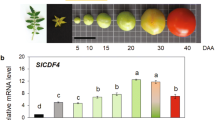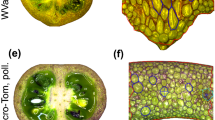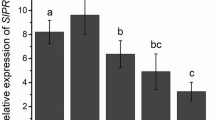Abstract
Fruit shape and ripening are major horticultural traits for many fruits and vegetable crops. Changes in fruit shape and ripening are often accomplished by altered cell division or cell expansion patterns. Gibberellic acids (GAs) are essential for tomato fruit development; however, the exact role and the underlying mechanism are still elusive. To elucidate the relationship between gibberellins and fruit shape and ripening in tomato, GA3 and gibberellin biosynthesis inhibitor paclobutrazol (PAC) were applied to tomato. Fruit shape index was increased when GA3 was applied, which was mainly attributed to the increased organ elongation. The expression levels of genes involved in cell elongation and expansion were altered at the same time. In addition, GA delayed the ripening time by regulating the transcript levels of ethylene-related genes. By contrast, PAC application decreased fruit shape index and shortened fruit ripening time. These results demonstrate that manipulation of GA levels can simultaneously influence tomato fruit shape and ripening. Further studies aimed to regulate fruit shape and ripening can be achieved by altering GA levels.





Similar content being viewed by others
References
Biemelt S, Tschiersch H, Sonnewald U (2004) Impact of altered gibberellin metabolism on biomass accumulation, lignin biosynthesis, and photosynthesis in transgenic tobacco plants. Plant Physiol 135:254–265
Binenbaum J, Weinstain R, Shani E (2018) Gibberellin localization and transport in plants. Trends Plant Sci 23:410–421
Bünger-Kibler S, Bangerth F (1982) Relationship between cell number, cell size and fruit size of seeded fruits of tomato (Lycopersicon esculentum Mill.), and those induced parthenocarpically by the application of plant growth regulators. Plant Growth Regul 1:143–154
Busov VB, Meilan R, Pearce DW, Ma C, Rood SB, Strauss SH (2003) Activation tagging of a dominant gibberellin catabolism gene (GA 2-oxidase) from poplar that regulates tree stature. Plant Physiol 132:1283–1291
Carver ST, Arnold MA, Byrne DH, Armitage AR, Lineberger RD, King AR (2014) Growth and flowering responses of sea marigold to daminozide, paclobutrazol, or uniconazole applied as drenches or sprays. J Plant Growth Regul 33:626–631
Cowling RJ, Harberd NP (1999) Gibberellins control Arabidopsis hypocotyl growth via regulation of cellular elongation. J Exp Bot 50:1351–1357
Czerednik A, Busscher M, Bielen BA, Wolters-Arts M, de Maagd RA, Angenent GC (2012) Regulation of tomato fruit pericarp development by an interplay between CDKB and CDKA1 cell cycle genes. J Exp Bot 63:2605–2617
Dostal H, Leopold A (1967) Gibberellin delays ripening of tomatoes. Science 158:1579–1580
Eriksson ME, Israelsson M, Olsson O, Moritz T (2000) Increased gibberellin biosynthesis in transgenic trees promotes growth, biomass production and xylem fiber length. Nat Biotechnol 18:784–788
Fos M, Nuez F, Garcı́a-martı́nez JL (2000) The gene pat-2, which induces natural parthenocarpy, alters the gibberellin content in unpollinated tomato ovaries. Plant Physiol 122:471–480
Galimba KD, Bullock DG, Dardick C, Liu Z, Callahan AM (2019) Gibberellic acid induced parthenocarpic ‘Honeycrisp’ apples (Malus domestica) exhibit reduced ovary width and lower acidity. Hortic Res 6:41
Gao Y, Wei W, Zhao X, Tan X, Fan Z, Zhang Y, Jing Y, Meng L, Zhu B, Zhu H, Chen J, Jiang CZ, Grierson D, Luo Y, Fu DQ (2018) A NAC transcription factor, NOR-like1, is a new positive regulator of tomato fruit ripening. Hortic Res 5:75
García-Valverde V, Navarro-González I, García-Alonso J, Periago MJ (2013) Antioxidant bioactive compounds in selected industrial processing and fresh consumption tomato cultivars. Food Bioprocess Technol 6:391–402
Hedden P, Phillips AL (2000a) Gibberellin metabolism: new insights revealed by the genes. Trends Plant Sci 5:523–530
Hedden P, Phillips AL (2000b) Manipulation of hormone biosynthetic genes in transgenic plants. Curr Opin Biotechnol 11:130–137
Hytönen T, Elomaa P, Moritz T, Junttila O (2009) Gibberellin mediates daylength-controlled differentiation of vegetative meristems in strawberry (Fragaria × ananassa Duch). BMC Plant Biol 9:18
Kende H, Zeevaart J (1997) The five “classical” plant hormones. Plant Cell 9:1197
Liu L, Wang Z, Liu J, Liu F, Zhai R, Zhu C, Wang H, Ma F, Xu L (2018) Histological, hormonal and transcriptomic reveal the changes upon gibberellin-induced parthenocarpy in pear fruit. Hortic Res 5:1
Livak KJ, Schmittgen TD (2001) Analysis of relative gene expression data using real-time quantitative PCR and the 2−ΔΔCT method. Methods 25:402–408
Mutasa-Göttgens E, Hedden P (2009) Gibberellin as a factor in floral regulatory networks. J Exp Bot 60:1979–1989
Olimpieri I, Siligato F, Caccia R, Soressi GP, Mazzucato A, Mariotti L, Ceccarelli N (2007) Tomato fruit set driven by pollination or by the parthenocarpic fruit allele are mediated by transcriptionally regulated gibberellin biosynthesis. Planta 226:877–888
Olszewski N, Sun TP, Gubler F (2002) Gibberellin signaling biosynthesis, catabolism, and response pathways. Plant Cell 14:S61–S80
Phillips AL (1998) Gibberellins in Arabidopsis. Plant Physiol Biochem 36:115–124
Ribeiro DM, Araújo WL, Fernie AR, Schippers JH, Mueller-Roeber B (2012) Translatome and metabolome effects triggered by gibberellins during rosette growth in Arabidopsis. J Exp Bot 63:2769–2786
Sakai M, Sakamoto T, Saito T, Matsuoka M, Tanaka H, Kobayashi M (2003) Expression of novel rice gibberellin 2-oxidase gene is under homeostatic regulation by biologically active gibberellins. J Plant Res 116:161–164
Sakamoto T, Morinaka Y, Ishiyama K, Kobayashi M, Itoh H, Kayano T, Iwahori S, Matsuoka M, Tanaka H (2003) Genetic manipulation of gibberellin metabolism in transgenic rice. Nat Biotechnol 21:909–913
Serrani JC, Fos M, Atarés A, García-Martínez JL (2007a) Effect of gibberellin and auxin on parthenocarpic fruit growth induction in the cv micro-tom of tomato. J Plant Growth Regul 26:211–221
Serrani JC, Sanjuán R, Ruiz-Rivero O, Fos M, García-Martínez JL (2007b) Gibberellin regulation of fruit set and growth in tomato. Plant Physiol 145:246–257
Serrani JC, Ruiz-Rivero O, Fos M, García-Martínez JL (2008) Auxin-induced fruit-set in tomato is mediated in part by gibberellins. Plant J 56:922–934
Seymour GB, Østergaard L, Chapman NH, Knapp S, Martin C (2013) Fruit development and ripening. Annu Rev Plant Biol 64:219–241
Southwick SM, Glozer K (2000) Reducing flowering with gibberellins to increase fruit size in stone fruit trees: applications and implications in fruit production. HortTechnology 10:744–751
Srivastava A, Handa AK (2005) Hormonal regulation of tomato fruit development: a molecular perspective. J Plant Growth Regul 24:67–82
Teh HF, Neoh BK, Wong YC, Kwong QB, Ooi TEK, Ng TLM, Tiong SH, Low JYS, Danial AD, Ersad MA, Kulaveerasingam H, Appleton DR (2014) Hormones, polyamines, and cell wall metabolism during oil palm fruit mesocarp development and ripening. J Agric Food Chem 62:8143–8152
Thomas SG, Phillips AL, Hedden P (1999) Molecular cloning and functional expression of gibberellin 2-oxidases, multifunctional enzymes involved in gibberellin deactivation. Proc Natl Acad Sci U S A 96:4698–4703
Tuan PA, Kim JK, Lee S, Chae SC, Park SU (2013) Molecular characterization of carotenoid cleavage dioxygenases and the effect of gibberellin, abscisic acid, and sodium chloride on the expression of genes involved in the carotenoid biosynthetic pathway and carotenoid accumulation in the callus of Scutellaria baicalensis Georgi. J Agric Food Chem 61:5565–5572
Van der Knaap E, Tanksley S (2003) The making of a bell pepper-shaped tomato fruit: identification of loci controlling fruit morphology in Yellow Stuffer tomato. Theor Appl Genet 107:139–147
Wang HS, Yu C, Tang XF, Wang LY, Dong XC, Meng QW (2010) Antisense-mediated depletion of tomato endoplasmic reticulum omega-3 fatty acid desaturase enhances thermal tolerance. J Integr Plant Biol 52:568–577
Wang HS, Yu C, Zhu ZJ, Yu XC (2011) Overexpression in tobacco of a tomato GMPase gene improves tolerance to both low and high temperature stress by enhancing antioxidation capacity. Plant Cell Rep 30:1029–1040
Wang L, Mu C, Du M, Chen Y, Tian X, Zhang M, Li Z (2014a) The effect of mepiquat chloride on elongation of cotton (Gossypium hirsutum L.) internode is associated with low concentration of gibberellic acid. Plant Sci 225:15–23
Wang HS, Yu C, Tang XF, Zhu ZJ, Ma NN, Meng QW (2014b) A tomato endoplasmic reticulum (ER)-type omega-3 fatty acid desaturase (LeFAD3) functions in early seedling tolerance to salinity stres. Plant Cell Rep 33:131–142
Wang GL, Que F, Xu ZS, Wang F, Xiong AS (2017) Exogenous gibberellin enhances secondary xylem development and lignification in carrot taproot. Protoplasma 254:839–848
Wang X, Zeng W, Ding Y, Wang Y, Niu L, Yao JL, Pan L, Lu Z, Cui G, Li G, Wang Z (2019) PpERF3 positively regulates ABA biosynthesis by activating PpNCED2/3 transcription during fruit ripening in peach. Hortic Res 6:19
Yamaguchi S (2008) Gibberellin metabolism and its regulation. Annu Rev Plant Biol 59:225–251
Yang C, Li H, Zhang J, Luo Z, Gong P, Zhang C, Li J, Wang T, Zhang Y, Ye Z (2011) A regulatory gene induces trichome formation and embryo lethality in tomato. Proc Natl Acad Sci U S A 108:11836–11841
Yuan Y, Xu X, Gong Z, Tang Y, Wu M, Yan F, Zhang X, Zhang Q, Yang F, Hu X, Yang Q, Luo Y, Mei L, Zhang W, Jiang CZ, Lu W, Li Z, Deng W (2019) Auxin response factor 6A regulates photosynthesis, sugar accumulation, and fruit development in tomato. Hortic Res 6:85
Zhang Y, Liu Z, Liu J, Lin S, Wang J, Lin W, Xu W (2017) GA-DELLA pathway is involved in regulation of nitrogen deficiency-induced anthocyanin accumulation. Plant Cell Rep 36:557–569
Funding
The research was supported by the Natural Science Foundation of Jiangsu Province (BK20170460), Doctoral Scientific Research Foundation of Shaanxi Xueqian Normal University (2018DS03), Guizhou Science and Technology Program No.Qiankehe Zhicheng (2019)2257, and Scientifc Research Foundation for Doctor from Huaiyin Institute of Technology (Z301B16531).
Author information
Authors and Affiliations
Contributions
SC and GLW initiated and designed the research. SC, XJW, and GFT performed the experiments. SC, XJW, and WQZ analyzed the data. SC and GLW revised the paper. All authors read and approved the final manuscript.
Corresponding author
Ethics declarations
Conflict of interest
The authors declare that they have no conflict of interest.
Additional information
Handling Editor: Peter Nick
Publisher’s note
Springer Nature remains neutral with regard to jurisdictional claims in published maps and institutional affiliations.
Electronic supplementary material
Supplementary material 1
Longitudinal sections of tomato fruits at different development stages after GA3 and PAC treatment. DAP indicates days after pollination; Scale bars = 2.5 mm. (JPG 2854 kb)
Rights and permissions
About this article
Cite this article
Chen, S., Wang, XJ., Tan, GF. et al. Gibberellin and the plant growth retardant Paclobutrazol altered fruit shape and ripening in tomato. Protoplasma 257, 853–861 (2020). https://doi.org/10.1007/s00709-019-01471-2
Received:
Accepted:
Published:
Issue Date:
DOI: https://doi.org/10.1007/s00709-019-01471-2




